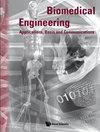CORRELATION OF POINCARE PLOT DERIVED STRESS SCORE AND HEART RATE VARIABILITY PARAMETERS IN THE ASSESSMENT OF CORONARY ARTERY DISEASE
IF 0.6
Q4 ENGINEERING, BIOMEDICAL
Biomedical Engineering: Applications, Basis and Communications
Pub Date : 2024-01-03
DOI:10.4015/s1016237223500400
引用次数: 0
Abstract
Atherosclerosis-generated coronary artery disease (CAD) causes the anomaly of autonomic activity. The assessment of autonomic balance under disease conditions is of clinical interest. Thus, this work aimed to evaluate the CAD using Poincare-derived stress score (SS) and sympathetic/sympathetic-parasympathetic (S/PS). A total of 60 male (50–55 years) volunteers including CAD ([Formula: see text]= 30) and control ([Formula: see text]= 30) participated in this work. Digital lead-II electrocardiogram (ECG) was recorded for 10 min in a supine position and filtered to remove noises. A total of 10 tachogram samples were computed from each subject for a 5 min ECG signal duration with a shift of 30 s on the processed signal using Acqknowledge 4.0 (Biopac Systems Inc., USA). The heart rate variability (HRV) parameters were computed from the obtained tachogram. The computed Poincare plot parameters were used to derive the SS and S/PS ratios. The regression model was employed to observe the correlation of SS and S/PS to the HRV parameters. The obtained results revealed reduced HRV with higher sympathetic and reduced parasympathetic activity under CAD than the control subjects. The autonomic dysfunction was observed with significantly higher values of SS and S/PS in CAD than in the control subjects. The S/PS was observed to be positively associated with LF/HF and SD2/SD1 parameters. While SS was found to be positively correlated to the LF and LF/HF parameters in CAD and control subjects. The obtained linear strong correlation of SS and S/PS with control and CAD subjects suggested the use of SS and S/PS as excellent sympathetic activity and sympathovagal balance markers.在评估冠状动脉疾病时,Poincare 图得出的压力评分与心率变异性参数之间的相关性
动脉粥样硬化引起的冠状动脉疾病(CAD)会导致自律神经活动异常。评估疾病条件下的自律神经平衡具有临床意义。因此,这项研究旨在使用 Poincare 衍生的压力评分(SS)和交感/交感-副交感(S/PS)对 CAD 进行评估。共有 60 名男性(50-55 岁)志愿者参与了这项工作,包括 CAD([公式:见正文]= 30)和对照组([公式:见正文]= 30)。志愿者取仰卧位,记录 10 分钟数字 II 导联心电图(ECG),并进行滤波以去除杂音。使用 Acqknowledge 4.0(Biopac Systems Inc.)根据获得的心动图计算心率变异性(HRV)参数。计算出的 Poincare 图参数用于得出 SS 和 S/PS 比率。采用回归模型观察 SS 和 S/PS 与心率变异参数的相关性。结果显示,与对照组相比,CAD 患者的心率变异降低,交感神经活动增加,副交感神经活动减少。与对照组受试者相比,CAD 受试者的 SS 和 S/PS 值明显较高,这表明自律神经功能紊乱。据观察,S/PS 与 LF/HF 和 SD2/SD1 参数呈正相关。而在 CAD 和对照组受试者中,SS 与 LF 和 LF/HF 参数呈正相关。SS和S/PS与对照组和CAD受试者的线性强相关性表明,SS和S/PS是极佳的交感活性和交感摇摆平衡标记物。
本文章由计算机程序翻译,如有差异,请以英文原文为准。
求助全文
约1分钟内获得全文
求助全文
来源期刊

Biomedical Engineering: Applications, Basis and Communications
Biochemistry, Genetics and Molecular Biology-Biophysics
CiteScore
1.50
自引率
11.10%
发文量
36
审稿时长
4 months
期刊介绍:
Biomedical Engineering: Applications, Basis and Communications is an international, interdisciplinary journal aiming at publishing up-to-date contributions on original clinical and basic research in the biomedical engineering. Research of biomedical engineering has grown tremendously in the past few decades. Meanwhile, several outstanding journals in the field have emerged, with different emphases and objectives. We hope this journal will serve as a new forum for both scientists and clinicians to share their ideas and the results of their studies.
Biomedical Engineering: Applications, Basis and Communications explores all facets of biomedical engineering, with emphasis on both the clinical and scientific aspects of the study. It covers the fields of bioelectronics, biomaterials, biomechanics, bioinformatics, nano-biological sciences and clinical engineering. The journal fulfils this aim by publishing regular research / clinical articles, short communications, technical notes and review papers. Papers from both basic research and clinical investigations will be considered.
 求助内容:
求助内容: 应助结果提醒方式:
应助结果提醒方式:


